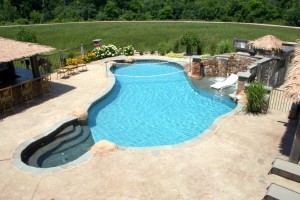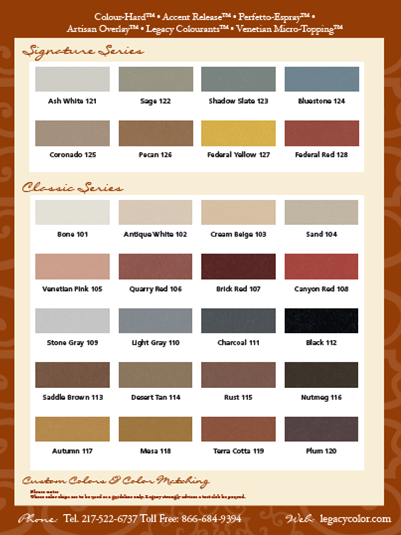Legendary Escapes offers a special process of coloring and texturing concrete for your pool patio projects. There are two methods of coloring concrete for a project. The concrete can be dyed in the truck, or a colored release can be used. The two options can also be used in a combination. It is difficult to match colors if several trucks will be used to deliver the concrete – so we always need to have a plan for which will work best for the patio situation.
If the colored release is chosen, on a Legendary Escapes pool, typically three or four colors are used to create a unique looks that has variations of color.
Here is the color chart for the LegacyColor System.
Legacy Color Release Samples (pdf) *actual colors will differ from what is represented on your computer screen.
If the colors are added directly to the truck, these are the Solomon Color Choices.
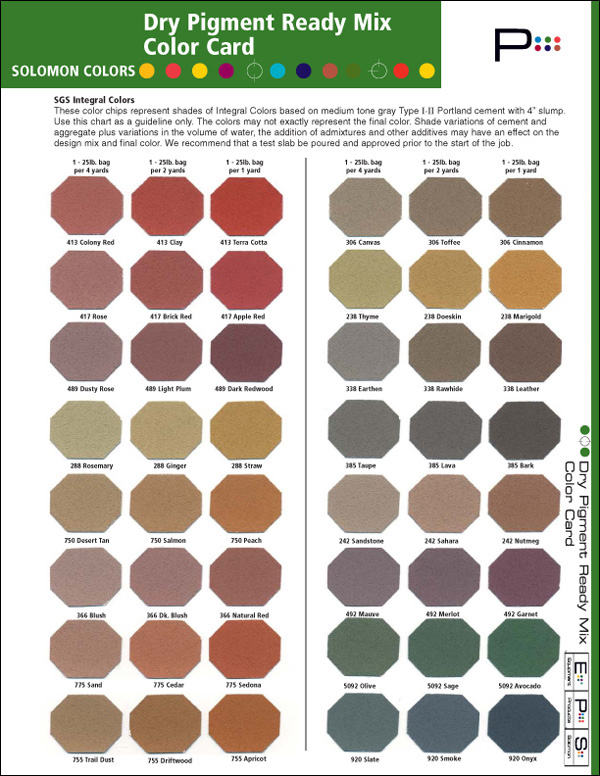 Dry_Pigment_Color_Card (pdf) *actual colors will differ from what is represented on your computer screen.
Dry_Pigment_Color_Card (pdf) *actual colors will differ from what is represented on your computer screen.
The full Legacy line is available for viewing here and does include some nice acid stain options, and some water based concrete dye options.
Common Patio Types for Swimming Pool Patio
The most common types of patio for a swimming pool include:
- Concrete – broom finished
- Exposed Aggregate
- Stamped
- Colored/Textured* (Clearly, our favorite)
- Tile (indoor use)
- Brick Pavers
Here are some of the pro’s and con’s of each type:
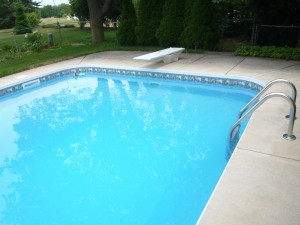 Broom Finished Concrete is sometimes the most economical option. It includes using basic concrete, in it’s lightest base color, and finishing with a broom for a relatively smooth surface (without polishing). A polished concrete pool deck would simply be way too slippery. The drawback of this style pool deck is that it looks very plain and basic, and if you have spent time and energy investing in a creative and artistic pool, this style patio will not necessarily offer a finishing touch. This style concrete also dates a pool. It was commonly used in the 70’s, 80’s and 90’s to put a 4′ walkway around three sides of the pool, with some extra for a table and chairs. The pool in the photo here was built in the late 80’s, and had a recent liner replacement done.
Broom Finished Concrete is sometimes the most economical option. It includes using basic concrete, in it’s lightest base color, and finishing with a broom for a relatively smooth surface (without polishing). A polished concrete pool deck would simply be way too slippery. The drawback of this style pool deck is that it looks very plain and basic, and if you have spent time and energy investing in a creative and artistic pool, this style patio will not necessarily offer a finishing touch. This style concrete also dates a pool. It was commonly used in the 70’s, 80’s and 90’s to put a 4′ walkway around three sides of the pool, with some extra for a table and chairs. The pool in the photo here was built in the late 80’s, and had a recent liner replacement done.
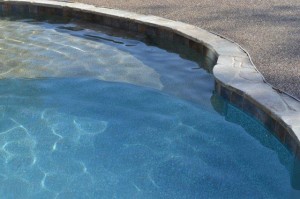 Exposed Aggregate Patios are certainly eye catching and beautiful. The drawback around a swimming pool is that you hardly dare to walk on it barefoot. The exposed aggregate, while it looks pretty also offers areas to stub your toe, and a rough, uneven surface for walking on. To get the shiny look that is often seen in this type of patio, the surface can also become slick when wet due to the sealant used on the patio. Remember as well, the darker the color, the warmer or hotter the patio will be to the touch – and bare feet are sensitive. Pretty = Yes, Comfortable = Maybe not so much.
Exposed Aggregate Patios are certainly eye catching and beautiful. The drawback around a swimming pool is that you hardly dare to walk on it barefoot. The exposed aggregate, while it looks pretty also offers areas to stub your toe, and a rough, uneven surface for walking on. To get the shiny look that is often seen in this type of patio, the surface can also become slick when wet due to the sealant used on the patio. Remember as well, the darker the color, the warmer or hotter the patio will be to the touch – and bare feet are sensitive. Pretty = Yes, Comfortable = Maybe not so much.
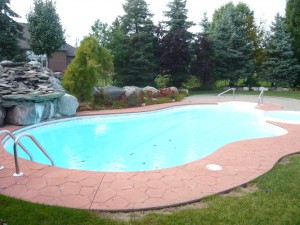 Stamped Concrete Patio is also a pretty option. Many people like the stamped shapes that make the pool look like it has a stone pattern in the surround. Traditional stamped patios offer a universal design in the concrete finish. They are usually finished with a sleek sealant to pull the color into the stamp design and leave them looking glossy. This will usually result in a patio that is warmer to the touch, and extremely slippery when wet. We do anticipate the area around the pool getting wet with swimmers and pool side activity. Pretty = Yes, Slippery = YES!
Stamped Concrete Patio is also a pretty option. Many people like the stamped shapes that make the pool look like it has a stone pattern in the surround. Traditional stamped patios offer a universal design in the concrete finish. They are usually finished with a sleek sealant to pull the color into the stamp design and leave them looking glossy. This will usually result in a patio that is warmer to the touch, and extremely slippery when wet. We do anticipate the area around the pool getting wet with swimmers and pool side activity. Pretty = Yes, Slippery = YES!
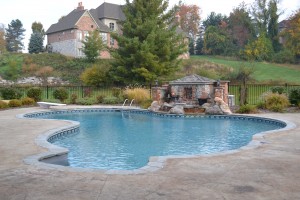 Textured Concrete Patio is clearly the Pool Guy’s favorite application for a swimming pool surround. It offers a nice textured finish that is a great design element, as well as easy to walk on with bare feet. The natural texture lines also allow for some disguise of the results of pouring concrete in Michigan. With our freeze/thaw cycle it is likely that cement will at some point in it’s life crack, and the natural texturing of the patio allows the cracks to be somewhat hidden and blend into the environment. We’ve found that the textured patios with slight color variations offer a good experience for bare feet in terms of warmth, ease of walking on, and texture to prevent slipping. Textured patios can be sealed to keep in the color, using a seal that penetrates into the concrete rather than forming a glossy layer on top. Pretty = yes, Slippery = no, Comfort for bare feet = good!
Textured Concrete Patio is clearly the Pool Guy’s favorite application for a swimming pool surround. It offers a nice textured finish that is a great design element, as well as easy to walk on with bare feet. The natural texture lines also allow for some disguise of the results of pouring concrete in Michigan. With our freeze/thaw cycle it is likely that cement will at some point in it’s life crack, and the natural texturing of the patio allows the cracks to be somewhat hidden and blend into the environment. We’ve found that the textured patios with slight color variations offer a good experience for bare feet in terms of warmth, ease of walking on, and texture to prevent slipping. Textured patios can be sealed to keep in the color, using a seal that penetrates into the concrete rather than forming a glossy layer on top. Pretty = yes, Slippery = no, Comfort for bare feet = good!
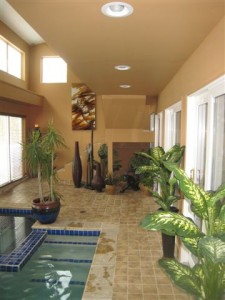 Tiled Swimming Pool Surrounds are most often used in indoor application where regular cleaning is needed. They are typically more slippery when wet than a concrete finish which is why there is no running around the pool! It is not recommended to tile the surround of an outdoor pool, especially in Michigan, where weather and other elements would be to much for the tile to handle.
Tiled Swimming Pool Surrounds are most often used in indoor application where regular cleaning is needed. They are typically more slippery when wet than a concrete finish which is why there is no running around the pool! It is not recommended to tile the surround of an outdoor pool, especially in Michigan, where weather and other elements would be to much for the tile to handle.
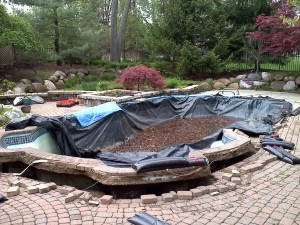 Brick Pavers around pools in Michigan are not such a good idea. Brick pavers look lovely. They often create geometric patters and designs that are eye catching and nice to look at. The problem with brick pavers surrounding a pool in Michigan are that we have more water, and groundwater to deal with than pools in other climates. When a pool is installed in Michigan, whether it is gunite, or vinyl, or fiberglass (Which has it’s own set of challenges), the patio is typically poured up to the edge of the pool or the coping. There is typically and expansion line left in between the coping and patio to allow for some ground movement, and then this line is filled with self leveling joint compound to prevent water from getting in between the patio and the pool. When brick pavers are used, there is no prevention of water from getting between the patio and the pool, and all of that water can float vinyl liners, and it can cause ground water pressure to become high surrounding a gunite or fiberglass pool. We have seen too many instances of a fiberglass pool popping out of the ground, cracking and shifting when there are contributing factors to instability. If you have the option to choose anything but brick pavers around your pool in Michigan, please do. You may be fine in the long run, but if you are not, it will be a very expensive issue to fix. (*The combination of brick pavers around this pool, as well as pumping too much water out of the pool may have contributed to this pop-out issue).
Brick Pavers around pools in Michigan are not such a good idea. Brick pavers look lovely. They often create geometric patters and designs that are eye catching and nice to look at. The problem with brick pavers surrounding a pool in Michigan are that we have more water, and groundwater to deal with than pools in other climates. When a pool is installed in Michigan, whether it is gunite, or vinyl, or fiberglass (Which has it’s own set of challenges), the patio is typically poured up to the edge of the pool or the coping. There is typically and expansion line left in between the coping and patio to allow for some ground movement, and then this line is filled with self leveling joint compound to prevent water from getting in between the patio and the pool. When brick pavers are used, there is no prevention of water from getting between the patio and the pool, and all of that water can float vinyl liners, and it can cause ground water pressure to become high surrounding a gunite or fiberglass pool. We have seen too many instances of a fiberglass pool popping out of the ground, cracking and shifting when there are contributing factors to instability. If you have the option to choose anything but brick pavers around your pool in Michigan, please do. You may be fine in the long run, but if you are not, it will be a very expensive issue to fix. (*The combination of brick pavers around this pool, as well as pumping too much water out of the pool may have contributed to this pop-out issue).
Keep in mind when choosing your pool patio style that the darker the colors in the patio, the warmer the patio will be. It’s a great idea to visit some patio styles and determine what your options are before making your choice. You will also want to take off your shoes and do the touch test to see if it works for you. We often have customers do this while choosing colors and styles of pool coping as well. It may look pretty, but if you can’t walk on it or sit comfortably dangling your feet into the pool, it may not be the best choice for your pool.
